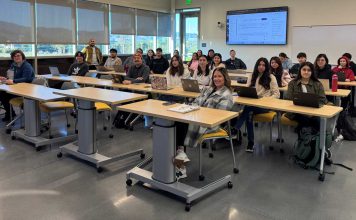
Making sure every downtown building meets modern earthquake
safety standards has been a priority for the city since the 1980s,
but a lack of data and the recession are the latest reasons why a
handful of dangerous buildings continue to stand.
Making sure every downtown building meets modern earthquake safety standards has been a priority for the city since the 1980s, but a lack of data and the recession are the latest reasons why a handful of dangerous buildings continue to stand.
Inspectors have identified 37 so-called “unreinforced masonry buildings” – which are more likely to crumble in an earthquake – lining Monterey Street and a few nearby roads.
Twelve of those buildings have been retrofitted or rebuilt, and 21 buildings have repair plans filed with the city.
City officials believe there are more, unidentified dangerous buildings, but the task of identifying them and then working with the property owners and neighbors, who sometimes don’t get along, is an arduous one, Councilman Perry Woodward said.
Woodward sits on a city task force that has unanimously recommended delaying a $10,000-per-month fine on property owners who don’t upgrade their structures. The monthly fee, passed by a 2006 city ordinance, will go into effect Nov. 16, but Woodward said he expects the council to delay collection until April 1, 2010. This will give the city more time to work with property owners, some of whom have decried the fine as extortion amid the recession.
“We’re running out of time, but ultimately our goal is not to fine people. Instead, we want to fix this problem to make the downtown safe in the event of an earthquake,” Woodward said. “On the other hand, we do need to motivate people.”
Woodward sits on the task force along with Mayor Al Pinheiro, Development Center Manager Kristi Abrams, downtown developer Gary Walton and local builder Steve Ashford – all of whom have first-hand experience with the issue and have spoken extensively with stakeholders.
For eight months last year, Ashford coordinated the demolition and rebuilding of four old, narrow buildings stretching from 7511 to 7525 Monterey St. They all shared common walls and had to come down together or not at all.
In addition to rallying tenants and owners, Ashford also had to convince the planning commission he should not have to hire an archeologist to be on site during the demolition of one historically sensitive building.
Aside from getting folks to cooperate, Woodward pointed to unidentified buildings around town that likely have sections of unreinforced masonry but are not completely unsafe. This was the case with the city youth center’s old home at 7400 Railroad St., where a routine inspection revealed some stucco walls and parapets were made from hollow clay tile and brick masonry – neither of which meet state earthquake standards.
“We just don’t have a complete grasp on the problem,” Woodward said.
Fixing the problems requires input from property owners, some of whom have bemoaned the cost of safety.
“There is no way we can justify reinforcing the buildings and expect to recapture the investment necessary to reinforce them. Nor can we pass on higher rents to our tenants to help pay for the improvements,” Mary Ann Milias wrote in an open letter to the council.
Milias’ family has owned various downtown buildings for generations, including two she sold right before the housing market collapsed, she wrote. She still owns the building at 7320 Monterey St., where Banning’s Upholstery operates.
The property is one of the four parcels – along with three vacant buildings on Gourmet Alley and Monterey Street – that has yet to pen a game plan with the city. However, Milias wrote that she has added Gilroy as an additional insured entity on her property.
Nearly 20 other property owners, tenants and stakeholders like Milias met with city officials last March to discuss options and what other cities are doing.
In San Luis Obispo, a city of about 44,000 people, more than 120 unreinforced buildings once existed. After the 6.5-magnitude San Simeon earthquake off the central California coast in 2003, the city hired a seismic coordinator, and officials there expect to have fixed all the buildings by July 2010.
Watsonville has 15 unsafe buildings but no comprehensive plan, according to a report prepared by Abrams.
The city of Morro Bay also lacks a specific plan and instead relies on a 1986 state law requiring cities to fix vulnerable structures.
Gilroy conducted its own reviews in the 1990s and passed an ordinance in 2006 that includes the $10,000 fine and an appeals process for property owners who do not comply. Another law passed by the city council in 2007 requires owners to fix buildings if they are vacant for more than 24 hours.
Millions of earthquakes occur across the world each year, most so small they go undetected. In Gilroy alone, more than 140,000 quakes, tremors and after-shocks of all sizes have rumbled through the city since 1979, according to the US Geological Survey National Earthquake Information Center.












